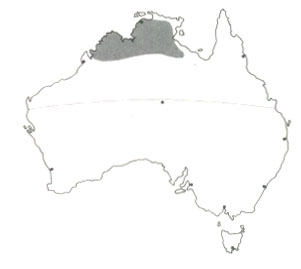![]()
 |
 |
DISTRIBUTION: Uncommon from north-western Australia to Arnhem Land; during wet season moves south into drier country where it breeds. |
Yellow-rumped Mannikin. |
Distribution Map |
|
IDENTIFICATION. LENGTH = 100 mm ADULTS: Sexes similar. Crown dull grey; back and wings cinnamon -brown; rump, upper tail-coverts and central tail-feathers golden strew-coloured; edges of tail-feathers brown. Face and underparts cream-buff; breast washed fawn; undertail-coverts black. Eye dark brown; bill and legs blue-grey. IMMATURES: Rump dirty-yellow; back and throat dark brown; underparts buff-grey.
|
NESTING. Breeds January-March. Nest compressed at sides; no entrance tunnel; 130 mm long, 120 mm high and 90 mm wide; of dry blades of grass, lined with fine grass stems; sited in tussocks of grass and reeds. Eggs: four or five; white; 17 X 12 mm.
|
|
FORMS.
|
|
AVIARY BREEDING. NESTING TYPES: I have found that these birds will nest almost anywhere although they will usually prefer a nest box including parrot nest boxes rather than build a nest of their own. I have seen these birds build nests in tea tree branches and planted trees but very rarely. Best results have been from boxes 150 mm square X 125 mm high with a 40 mm access hole in the front and a small landing platform just below the entrance. (See the Plans page for more information) FEEDING: A general finch mix is ideal for this bird. Birds will also readily take seeding grasses and live food. However I have had seen these birds breed successfully with just a mixed seed diet. Egg and biscuit will also be taken readily. OTHER FEEDS: Cuttlebone and shell grit should be supplied at all times. SPECIAL REQUIREMENTS: There are no special requirements for this species. However care should be taken not to house this species with the Masked Finch or the Long-tailed Finch or any of the subspecies.
|
| AVIARY SPECIFICATIONS. | WIRE MESH: 1/4 x 1/4 or 6 mm x 6 mm | Also known as mouse wire |
| LENGTH: 11ft 6in or 3575 mm | WIDTH:6ft or 1800 mm | HEIGHT: 8ft or 2400 mm |
| SHED: Half the aviary should be enclosed.
These are recommendations only and individual breeders may have different dimensions and specifications.
|
FLOOR: I have found a dirt floor preferable. |
OTHER: |
|
BREEDER SUBMISSIONS. |
|
| From |
![]()
Author
P Campbell
Copyright © 2002 P. Campbell. All rights reserved.
Revised: April 23, 2002
.